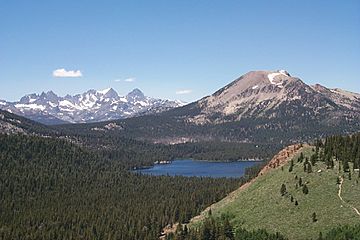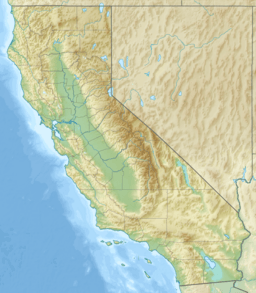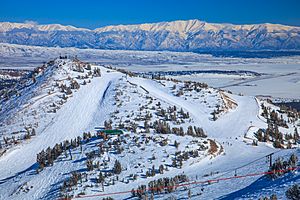Mammoth Mountain facts for kids
Quick facts for kids Mammoth Mountain |
|
|---|---|

Mammoth Mountain from the south, with Ritter Range behind
|
|
| Highest point | |
| Elevation | 11,059 ft (3,371 m) NAVD 88 |
| Prominence | 1,647 ft (502 m) |
| Geography | |
| Parent range | Sierra Nevada |
| Topo map | USGS Mammoth Mountain |
| Geology | |
| Age of rock | About 50,000 to 200,000 years |
| Mountain type | Lava dome complex |
| Last eruption | 1260 ± 40 years |
| Climbing | |
| Easiest route | Gondola |
Mammoth Mountain is a large lava dome complex in California, U.S. It is partly located near the town of Mammoth Lakes, California. This mountain is found within the Inyo National Forest, stretching across Madera and Mono Counties. It is famous for being home to a big ski area, mostly on the Mono County side.
Mammoth Mountain was created by many volcanic eruptions. These eruptions finished about 57,000 years ago. Even today, Mammoth Mountain releases volcanic gases. These gases can be dangerous and have caused trees to die. They also led to the deaths of ski patrollers in 2006.
Contents
What is Mammoth Mountain?
Mammoth Mountain is a type of volcano called a lava dome complex. It is located in Mono County, California. This mountain sits at the edge of the Long Valley Caldera, which is a huge volcanic crater. Mammoth Mountain is made up of about 12 overlapping domes. These domes are formed from volcanic rocks called rhyodacite and dacite.
How Mammoth Mountain Formed
The domes of Mammoth Mountain were built over a long time. This happened through many eruptions from 110,000 to 57,000 years ago. These eruptions created a volcano that stands about 11,059 feet (3,371 meters) tall. During this period, very large dacite eruptions happened about every 5,000 years.
The volcano is still active, but only with small eruptions. The biggest recent one was a minor phreatic (steam) eruption. This steam eruption happened about 700 years ago.
Volcanic Connections
Mammoth Mountain is also at the southern end of the Mono-Inyo chain. This chain is a line of volcanic craters. The molten rock (magma) that feeds Mammoth Mountain is different. It comes from a separate source than the magma for the Long Valley Caldera or the Inyo Craters.
The mountain is mostly made of dacite and rhyolite rocks. Some of these rocks have been changed by hot water and steam. This process comes from fumaroles, which are vents that release steam and gases.
Volcanic Gas and Its Effects
Mammoth Mountain releases a lot of carbon dioxide gas. This gas comes out of its southern side, near Horseshoe Lake. This causes an issue called mazuku in that area. Mazuku means "evil wind" and refers to places where carbon dioxide collects.
Carbon Dioxide in the Soil
The amount of carbon dioxide in the ground there is very high. It can range from 20 to 90 percent CO2. About 50 to 150 metric tons of carbon dioxide gas are released every day. This high amount of CO2 causes trees to die in six areas. These areas cover about 170 acres (0.69 square kilometers).
At first, people thought the trees were dying because of a drought. They also thought it might be from a disease. But these ideas did not explain why all trees died, no matter their age or health. In 1990, a U.S. Forest Service Ranger got sick from suffocation. This happened after being in a cabin near Horseshoe Lake.
Discovering the Cause
Measurements around the lake showed high CO2 levels. Restrooms and tents had more than 1% CO2, which is toxic. A small cabin had a deadly 25% concentration of CO2. Normally, soil has less than 1% CO2, which is healthy. But in the tree-kill areas, soil CO2 was 20% to 90%.
This extra CO2 was found to be the reason trees were dying. Tree roots need to take in oxygen directly. High CO2 levels reduce the oxygen available to them. Researchers also found that Mammoth Mountain releases about 1,300 metric tons of CO2 daily. Since 2003, the CO2 in the soil gas is watched all year. This happens at four spots, including near the ski area.
Where the Gas Comes From
The carbon dioxide likely comes from two places. It comes from magma (molten rock) that has moved into the mountain. It also comes from limestone rocks that are heated by this magma. The gas from different spots around Mammoth Mountain is very similar. This suggests there might be a large gas pocket deep under the mountain. The gas escapes through faults (cracks in the earth) to the surface.
Measurements of helium gas also support this idea. They show the gases come from the same source as those from Mammoth Mountain Fumarole. There is also evidence that the amount of CO2 being released is going down. The emissions were highest in 1991.
In April 2006, three members of the Mammoth Mountain Ski Area ski patrol died. They were on duty and died from suffocation by carbon dioxide. This happened when they fell into a fumarole on the mountain's slopes.
Fun Activities at Mammoth Mountain
Mammoth Mountain is home to the Mammoth Mountain Ski Area. Dave McCoy started this ski area in 1953. In the winter, Mammoth is a popular place for skiing, snowboarding, and snowmobiling. It is the highest ski resort in California.
Winter Fun
Mammoth is known for getting a lot of snow. It receives about 400 inches (10 meters) of snow each year. It also gets about 300 sunny days out of 365. This is because of its special location in the Sierra Nevada mountains.
Summer Fun
In the summer, the ski gondolas are still used. Mountain bikers and tourists ride them to the top. From the summit, you can see amazing views. You can see the Long Valley Caldera to the east. You can also see other Sierra peaks to the west, south, and north. South of the mountain, there are many lakes. These lakes are popular spots for tourists in the summer.




